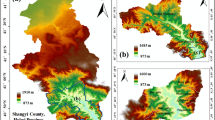The urgency of the problem of pollution of regulated water courses by floating debris is shown. The volume, composition, and decomposition time of floating debris are estimated. The role of hydroelectric power plants in combating floating debris in reservoirs is analyzed. An approach to managing such debris flows is proposed.
Similar content being viewed by others
References
Dams and Development: New Methodological Basis for Decision-Making: Report of the World Commission on Dams [in Russian], Word Wildlife Fund (WF), Moscow (2009).
D. Zupanski and Z. Gavrilovic, “Problem of floating debris in the Danube and Tamiš Rivers,” J. Region. Coop., DANUBIUS (2011).
In the Hubei Province Three Gorges anti-pollution project three years invest the approximately 2,350,000,000 yuan, Xinhua, April 19, 2007.
Trash accumulates at Three Gorges Dam, WSJ, Aug. 2 (2010). https://www.wsj.com/articles/SB10001424052748704271804.5754044604533608905.
Yu. S. Vasil’ev, S. N. Dobrynin, V. I. Maslikov, T. S. Tikhonova, and I. G. Kudryasheva, “Expert information system ‘Ecological Safety of HPP’,” Gidrotekh. Stroit., No. 3, 35–41 (2000).
Yu. S. Vasil’ev, I. G. Kudryasheva, and V. I. Maslikov, “Monitoring the state of the natural environment in HPP pools for substantiating environmental protection measures,” Tr. SPbGTU. Stroit., No. 502, 317–322 (2007).
M. C. M. Blettler, M. S. Ulla, A. P. Rabuffetti, and N. Garello, “Plastic pollution in freshwater ecosystems: macro-, meso-, and microplastic debris in a floodplain lake,” Environ. Monit. Assess, 189(11), 581(2017).
M. C. M. Blettler, E. Abrial, F.. Khan, N. Sivri, and L. A. Espinola, “Freshwater plastic pollution: Recognizing research biases and identifying knowledge gaps,” Water Res., 143, 416–424 (2018).
Yu. S. Vasil’ev, V. V. Elistratov, and V. I. Maslikov, “On increasing the ‘ecological cleanness’ of HPP,” in: Safety of Power Structures. Issue 6 [in Russian], AO NIIÉS, pp. 37–44 (2000).
J. Gasperi, R. Dris, T. Bonin, V. Rocher, and B. Tassin, “Assessment of floating plastic debris in surface water along the Seine River,” Environ. Pollut., 195, 163–166 (2014).
L. C. Lebreton, J. Van Der Zwet, J. W. Damsteeg, et al., “River plastic emission to the world’s oceans,” Nat. Commun., 8, 15611 (2017).
”From India to Spain, plastic waste becoming a global threat to ecosystems,” The Mainichi, July 16 (2018). https://maini - chi.jp/english/articles/20180716/p2a/00m/0na/024000c
D. S. C. Oliveura, M. J. B. Guimarães, J. L. Portugal, and Z. Medeiros, “The socio-demographic, environmental and reservoir factors associated with leptospirosis in the urban area of north-eastern Brazil,” Ann. Trop. Med. Parasitol., 103(2), 149–157 (2009).
D. Eerkes-Medrano, R. C. Thompson, and D. C. Aldridge, “Microplastics in freshwater systems: Areview of the emerging threats, identification of knowledge gaps and prioritisation of research needs,” Water Res., 75, 63 – 82 (2015).
G. B. Jose, “The pollution of the marine environment by plastic debris: A review,” Mar. Pollut. Bull., 44, 842–852 (2002).
J. F. Provencher, A. L. Bond, and M. L. Mallory, “Marine birds and plastic debris in Canada: A national synthesis and a way forward,” Environ. Rev., 23(1), 1–13 (2015).
Yu. S. Vasil’ev and D. S. Shchavelev (eds.), Hydropower and Auxiliary Equipment of Hydropower Plants: Handbook in Two Volumes. Vol. 2. Auxiliary Equipment of Hydropower Plants [in Russian], Énergoatomizdat (1990), 336 pp.
Tennessee Valley Authority, Duke Power Company and Other Utilities Use UMI Trash Skimmers. Mud Cat, November 17 (2016). Available at http://www/mudcatdredge.com/2016/11/17 (Accessed 22.01.2019).
Trash Wheel Project, Available at http://www.baltimorewaterfront.com/healthy-harbor/water-wheel (Accessed 22.01.2019).
Author information
Authors and Affiliations
Corresponding author
Additional information
Translated from Gidrotekhnicheskoe Stroitel’stvo, No. 4, April 2019, pp. 48 – 52.
Rights and permissions
About this article
Cite this article
Vasil’ev, Y.S., Maslikov, V.I., Shilin, M.B. et al. New Challenges and Possibilities of Hydroelectric Power Plants in Combating Pollution of Watercourses by Floating Debris. Power Technol Eng 53, 314–318 (2019). https://doi.org/10.1007/s10749-019-01077-x
Published:
Issue Date:
DOI: https://doi.org/10.1007/s10749-019-01077-x




